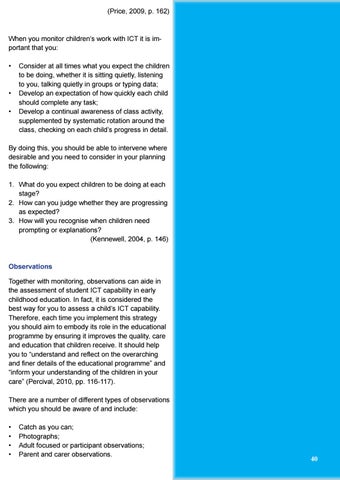(Price, 2009, p. 162)
When you monitor children’s work with ICT it is important that you: • Consider at all times what you expect the children to be doing, whether it is sitting quietly, listening to you, talking quietly in groups or typing data; • Develop an expectation of how quickly each child should complete any task; • Develop a continual awareness of class activity, supplemented by systematic rotation around the class, checking on each child’s progress in detail. By doing this, you should be able to intervene where desirable and you need to consider in your planning the following: 1. What do you expect children to be doing at each stage? 2. How can you judge whether they are progressing as expected? 3. How will you recognise when children need prompting or explanations? (Kennewell, 2004, p. 146)
Observations Together with monitoring, observations can aide in the assessment of student ICT capability in early childhood education. In fact, it is considered the best way for you to assess a child’s ICT capability. Therefore, each time you implement this strategy you should aim to embody its role in the educational programme by ensuring it improves the quality, care and education that children receive. It should help you to “understand and reflect on the overarching and finer details of the educational programme” and “inform your understanding of the children in your care” (Percival, 2010, pp. 116-117). There are a number of different types of observations which you should be aware of and include: • • • •
Catch as you can; Photographs; Adult focused or participant observations; Parent and carer observations.
40











